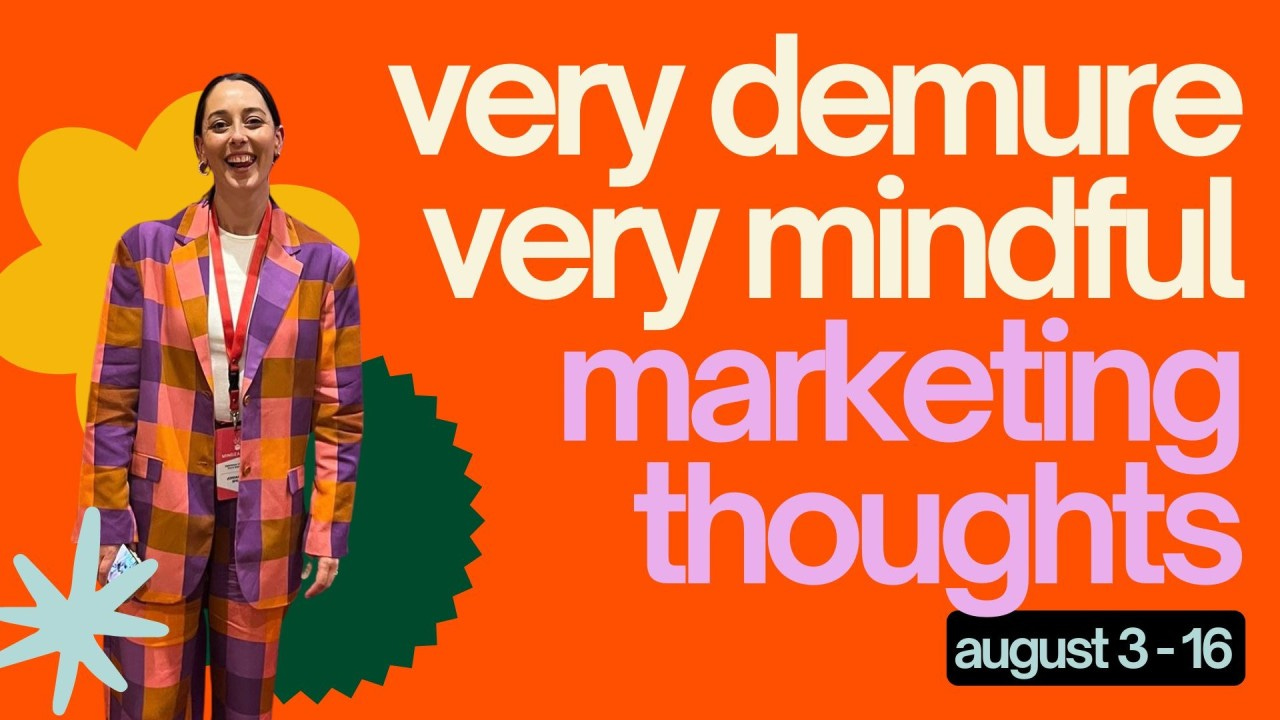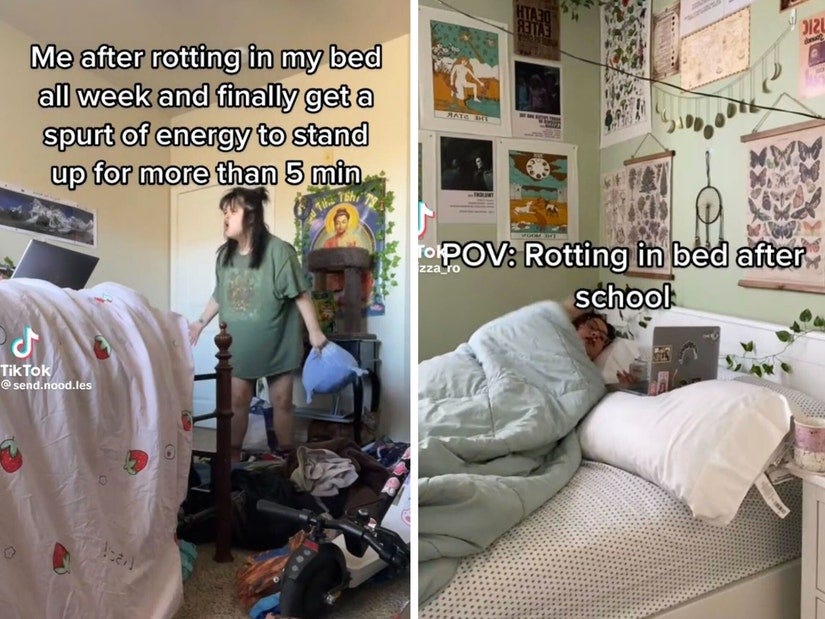It’s perhaps too self indulgent to write a Substack about branding, and then proceed to reference your own brand’s campaign. Still, if Kendrick can use an entire album to declare himself the GOAT (which we’re in total agreement on), then I’m going to flex the self-congratulating rule a bit… So, here goes: this week, Oxford announced its Word of the Year, and our pick was ‘brain rot’.
I should start by saying we’re by no means unique in doing this. You might’ve been hit from all sides with words for this year if you pay attention/have been looking for cutesy sound bites to extrapolate on for content (hey, none of us are above the hustle). Cambridge chose ‘manifest’, Collins went early with ‘brat’ (and who could blame them - more on this in a sec), and Dictionary.com took the other side of that viral coin in ‘demure’. Looking across them, I think the combination feels like a very accurate look back at 2024, where the pervasive feeling as we reflect is: what the fck just happened?
I’ve observed or worked on Oxford’s campaign in some capacity for many years now and, while every single year is a different ride, what’s true is that the best years hold a pretty candid mirror up to our obsessions, our pervading mood, and sometimes even our needs. Having worked on our campaigns for ‘goblin mode’ in 2022 and ‘rizz’ in 2023, it felt like nothing short of a collective exhale: bombarded from pillar to post by prophecies of AI takeovers, physical, economic, social and mental health disintegration in the wake of a global pandemic, very real climate crises, war, and genocides, we struck on something close to relief from years of unrelenting bin-fires.
And yet, the bin-fires kept raging.
So this year’s team chose a mirror that calls it like it sees it: we’re all here now, and we’re all mad here. ‘Brain rot’ is unarguably a sign of the times (despite its long and storied past), and the times are: mindless scrolling through irrelevant shit until we feel nothing. Like ‘goblin mode’ before it, there’s another delirious wave of surfeited, bleary-eyed folks glued to their feeds, come to join the chorus of assent. I feel this, too! As the brand behind the observation, you bask in the satisfaction of saying something that resonates, of hitting that cultural moment, and mood.
But as a fellow bleary-eyed, surfeited, phone goblin? I came to Substack for some quiet, and to think.
I think the apple’s rotten - right to the core
2024 has been a year obsessed with rot.
‘Bed rotting’ rose to consciousness early this year: a buck against ‘the grind’ and our capitalistic obsession with productivity. In what I think we can all agree was a pretty inevitable move, generations coming into working-age or higher-ed/high school for whom the pandemic years were formative, are embracing their homes and personal private spaces (online and off) like never before.
One of the really frustrating things about living through, and observing, this time is that the narrative we’re choosing to construct around this behaviour is woefully, predictably: ‘those darn lazy kids, they don’t know how good they got it!’ Rather than considering addressing concerns wrought in the wake of literally every single widespread, fatal pandemic that has occurred in human history - issues with trust in community, issues with anxiety about health and personal space, and issues with listlessness and depression brought on by socioeconomic conditions worsening - we pin this wave of apathy to ‘not wanting to get back to work!'
Now, don’t get me wrong - I am up for dismantling the patriarchy and all associated capitalism-fuelling feudalistic systems we are force-fed as much as the next middle class woman of a certain age, but I do caution a trend that makes doctors warn you about concrete links to depression and sleep disruption may not be the best way to fight that fight. Still, in bed rotting we see a way to externalise some of those feelings we might not be able to give voice to about what we continue to live through: ‘Numb it all. I’m not ready to move on.’

In this way, maybe this spread of ‘punk rot’ gave birth to the ‘brat’ movement (I think we’re calling that ‘indie sleaze’?) - birthed by a colour as much as an album. The acid, insipid, inescapable green of Charli XCX’s sixth studio album drenched the internet in lofi artwork and attitude. Somewhere between an apple sour and Frankenstein’s monster, we were mesmerised by the zombified quality of this sickly pallor as it seeped into every surface before our eyes.
Charli herself describes brat as: “You're just like that girl who is a little messy and likes to party and maybe says some dumb things sometimes.” It’s fcked up, and it likes it, invoking the drawling nonchalance of iconic obsessions of the early internet like Paris and Nicole in their ‘underwear is a complete outfit’ clubbing-and-being-rich days. It’s interesting to consider this parallel - the rise of the internet, the rise of the celebrity rich person, how they feed one another - against the backdrop of one of the worst recessions in living memory. I’m sure it’s no coincidence, then, that as we continue to face successive humanitarian crises, its these familiar faces that grace the January cover of Glamour magazine. When bad things happen, we love to gorge on excess - even when our gorging is living vicariously through another heiress (or pop star, as the case may be).
But it was more than just attitude that delivered the sound of ‘24: brat’s big, bombastic bass, with rave samples and remixes coming out the wazoo, hit on such a cultural nerve - such a need - that we named an entire season of the year after it. The audaciousness of that sound, the return to rave culture, and a time when we could be together, dance together, and sweat together (the latter forming the name of Charli’s now infamous world tour) without fear brought out a primal desire that we’d been burying in anxiety for too long.
And then inevitably, the influencers came, and then the brands came, and then (like every piece of art that catches fire on social) it all got commercial, and lost some of its original intention. Our collective timer for the amount of hype a woman can receive went off, the world grew tired. But in the success of ‘brat’ we see a striking, summertime, profitable resemblance to bed rotting before it. The message is simple: ‘Numb it all. I’m not ready to move on.’
Are we all super-spreaders?

The slow decay inferred by all this rotting is juxtaposed with the hyper-speed of our new trend cycle, chewing up and vomiting out sounds and aesthetics insatiably. When I think about virality this year, of course my mind goes to Jools Lebron who, one could easily argue, was robbed of her full fifteen minutes because of how viral she went, and how quickly we tired of ‘very demure, very mindful’. More recently (and more telling of where I spend my time on the internet), I think of Jaguar.
I’ve already spent an entire Stack talking about what happened to the teaser announcement of that rebrand on LinkedIn so I won’t revisit it, but it was another one of 2024’s more telling trend waves. The ferocity and surge of emotions from shock, horror, disgust, outrage, through to altruistic meditation and performative goodwill caught fire from platform to platform. Everyone who had ever veered near ‘brand strategist’ on their CV, qualified or not, felt personally called upon to deliver critique or deliverance. The dizziness of the swing from (quite frankly, horrific) Scooby Doo-style unmasking in right-wing media of those behind the rebrand and their choices of clothing, through to the CEO of Jag calling out the… entire internet(?) for being bigoted and vile, would I’m sure have had us all confused in any other year. In 2024, though, it’s pretty clear that this is how the internet feeds itself, now. We all want to gorge on virality, until it makes us sick.
Much like that summer-long, acid green rave, there’s a small and finite moment when a new trend takes off online it can feel like being at an invite-only party, occupying the highest echelons of taste before something goes more mainstream. It taps into our most fundamental need: to belong. This kind of hardwired tribalism is what makes social work, it’s what the algorithm is built off of, and at its heart, is branding. When you choose to jump onto a trend, you’re signalling something about yourself to whoever is watching - I endorse this idea, this message, this thought to travel a little further. What has been so fascinating about this year in particular is the accelerant effect of these pile ons facilitated by tech, and our complicity in super-spreading them at warp speed.
In Monday’s letter (part two of this deep dive), I’ll take a deeper look at what our obsession with trend-jumping and tribalism says about where we are now, the effect that is having on creativity, originality, and taste, and where we go from here as we look to 2025.







Your ability to keep on top of these trends continues to impress me. Also: bin-fires❤️🔥